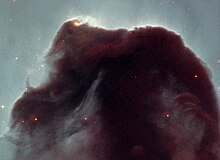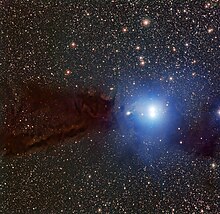Dark cloud
In astronomy, dark clouds or dark nebulae are large clouds of interstellar matter that absorb the light from objects behind them . They can be observed when they darken or completely hide background stars (e.g. Barnard 68 ), or when they obscure parts of emission or reflection nebulae (e.g. Horsehead Nebula ).
The nature of dark clouds was discovered by the astronomer Edward Emerson Barnard . The Barnard catalog named after him lists over 300 dark clouds, for example the Horsehead Nebula bears catalog number B 33.
description
The shape of such dark clouds is highly irregular, without clearly defined outer borders and sometimes with an intertwined shape. The largest dark clouds are visible to the naked eye as dark spots against the lighter background of the Milky Way . The clearest examples are the coal sack in the Southern Cross and the apparent “division” of the Milky Way between the constellations swan and eagle .
Magnitude
The hydrogen in these opaque clouds is in the form of molecules ( molecular clouds ). The largest clouds of this type, giant molecular clouds (GMC), are up to 150 light years in size. They have an average density of 100 to 300 molecules per cm³, have a million times the mass of the sun and thus make up a considerable proportion of the mass in the interstellar medium.
internal structure
Molecular clouds consist mainly of gas ( gas cloud ) and some thread-like dust , but can also include a large number of stars. The centers of the clouds are not visible in visible light , but can be perceived through the microwave radiation of their molecules; This type of radiation is not absorbed by the dust and can therefore escape from the cloud.
The clouds have an internal magnetic field that counteracts their own gravitation . Their internal temperature is only 7 to 15 K . The clouds have densely populated areas of different sizes, from star sizes to light-years-sized structures.
Connection with star formation
It is assumed that new stars are formed inside high-density dark clouds, the globules . Often they are also directly in front of extensive H-II areas .
Influence on passing stars
Giant molecular clouds play an important role in the dynamics of the galaxy : If a star passes close to such a cloud, its gravitational pull can cause a noticeable perturbation of its space movement. After repeated encounters of this type, a middle-aged star has significant velocity components in different directions, rather than the almost circular orbit of a newly formed star around the center of the Milky Way (young stars have the same orbit as the GMC in which they were formed). This gives astronomers an additional tool for determining the age of stars and helps to explain the observable thickness of the galactic disk .
Entry of the solar system into a dark cloud
A dark cloud is a cloud of interstellar gas and dust that is far larger than the solar system and can measure up to 150 light years across. If the solar system were to drift through such a nebula, the cosmic dust could darken the light from the stars. Furthermore, a dark cloud with a density of 100 to 300 molecules per cm³ could strongly compress the heliosphere , whereby its matter could reach the interior of the solar system and even darken the sun. This could disrupt photosynthesis or make it impossible. Some researchers suspect such a "foggy winter" behind past ice ages and mass extinctions .
literature
- Christian Feldt: Fragmentation in the W80 dark cloud. Early stages of star formation. Dissertation, University of Hamburg 1991.
- S. & P. Friedrich: Handbook Astronomy. Oculum-Verlag, Erlangen 2015
- Georg Hartwig: Investigations into the Auriga dark cloud. In: Journal of Astrophysics. Vol. 17 (1939), Issue 3/5, pp. 191-245, ISSN 0372-8331 .
- Joachim Krautter among others: Meyers Handbuch Weltall. 7th edition. Meyers Lexikonverlag, Mannheim 1994, ISBN 3-411-07757-3 .
- Klaus J. Seidensticker: Morphology and nature of the dust of the dark cloud "coal sack". Dissertation, University of Bochum 1987.
- Helmut Zimmermann and Alfred Weigert : ABC Lexicon Astronomy. Spectrum Academic Publishing House , Heidelberg 2000.
Individual evidence
- ↑ How Will Humans Meet Their End? 5 cosmic risks . Retrieved November 29, 2014.



